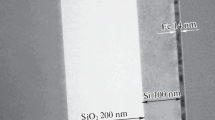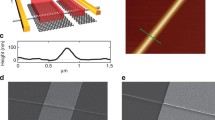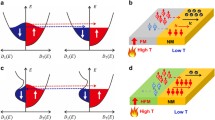Abstract
Semiconductor nanowires are unique materials for studying nanoscale phenomena; the possibility of forming silicon nanowires on bulk silicon-on-insulator substrates in a top-down process ensures complete incorporation of this technology into integrated electronic systems. In addition, the use of ferromagnetic contacts in combination with the high quality of ferromagnetic–semiconductor interfaces open up prospects for the use of such structures in spintronics devices, in particular, spin transistors. A simple approach is proposed to create semiconductor nanowire-based active devices, specifically, bottom-gate Schottky-barrier field-effect transistors with a metal (Fe) source and drain synthesized on a silicon-on-insulator substrate and the transport characteristics of the designed transistors are investigated.



Similar content being viewed by others
REFERENCES
H. Riel, L, B.-E. Wernersson, M. Hong, and J. A. del Alamo, MRS Bull. 39, 668 (2014). https://doi.org/10.1557/mrs.2014.137
X. J. Huang and Y. K. Choi, Sens. Actuators, B 122, 659 (2007). https://doi.org/10.1016/j.snb.2006.06.022
A. Noy, Adv. Mater. 23, 807 (2011). https://doi.org/10.1002/adma.201003751
H. Wang, L. A. Zepeda-Ruiz, G. H. Gilmer, and M. Upmanyu, Nat. Commun. 4, 1956 (2013). https://doi.org/10.1038/ncomms2956
Y. Cui, Z. Zhong, D. Wang, et al., Nano Lett. 3, 149 (2003). https://doi.org/10.1021/nl025875l
H. Cui, M. Cruz-Correa, F. M. Giardiello, et al., Science 299, 1753 (2003). https://doi.org/10.1126/science.1080313
F. Allibert, T. Ernst, J. Pretet, et al., Solid-State Electron. 45, 559 (2001). https://doi.org/10.1016/S0038-1101(01)00074-0
S.-F. Hu, Y.-C. Wu, C.-L. Sung, et al., IEEE Trans. Nanotechnol. 3, 93 (2004). https://doi.org/10.1109/TNANO.2003.820784
S. M. Koo, M. D. Edelstein, Q. Li, et al., Nanotechnology 16, 1482 (2005). https://doi.org/10.1088/0957-4484/16/9/011
T. Mikolajick, A. Heinzig, and J. Trommer, Phys. Status Solidi RRL 7, 793 (2013). https://doi.org/10.1002/pssr.201307247
J. P. Colinge, C. W. Lee, A. Afzalian, et al., Nat. Nanotechnol. 5, 225 (2010). https://doi.org/10.1038/nnano.2010.15
I. A. Yakovlev, S. N. Varnakov, B. A. Belyaev, et al., JETP Lett. 99, 527 (2014). https://doi.org/10.1134/S0021364014090124
N. V. Volkov, A. S. Tarasov, D. A. Smolyakov, et al., AIP Adv. 7, 015206 (2017). https://doi.org/10.1063/1.4974876
A. S. Tarasov, M. V. Rautskii, A. V. Lukyanenko, et al., J. Alloys Compd. 688, 1095 (2016). https://doi.org/10.1016/j.jallcom.2016.07.138
A. S. Tarasov, A. V. Lukyanenko, M. V. Rautskii, et al., Semicond. Sci. Technol. 34, 035024 (2019). https://doi.org/10.1088/1361-6641/ab0327
ACKNOWLEDGMENTS
This study was carried out on equipment of the Krasnoyarsk Regional Center for Collective Use, Krasnoyarsk Scientific Center, Siberian Branch, Russian Academy of Sciences.
Funding
This study was supported by the Ministry of Science and Higher Education of the Russian Federation, the Presidium of the Russian Academy of Sciences (Program no. 32 “Nanostructures: Physics, Chemistry, Biology, and Fundamentals of Technologies”), and the Russian Foundation for Basic Research, the Government of Krasnoyarsk Territory, and the Krasnoyarsk Territorial Foundation for Support of Scientific and R&D Activities, project no. 18-42-243 022.
Author information
Authors and Affiliations
Corresponding author
Additional information
Translated by E. Bondareva
Rights and permissions
About this article
Cite this article
Lukyanenko, A.V., Tarasov, A.S., Shanidze, L.V. et al. Technique for Fabricating Ferromagnetic/Silicon Active Devices and Their Transport Properties. J. Surf. Investig. 15, 65–69 (2021). https://doi.org/10.1134/S1027451021010109
Received:
Revised:
Accepted:
Published:
Issue Date:
DOI: https://doi.org/10.1134/S1027451021010109




